The AMD Radeon RX 7900 XT is the slightly smaller sibling of the just-announced Radeon RX 7900 XTX. Using the same RDNA 3 architecture and GPU chiplets, but with one fewer MCD (Memory Cache Die), it will presumably land just a bit lower down on our GPU performance hierarchy when it arrives on December 13.
We have to admit that the naming certainly represents a bit of an annoyance. The only difference between the RX 7900 XTX and the 7900 XT is one letter, and yet the latter will definitely have less performance. For all the people that were up in arms over the RTX 4080 16GB and RTX 4080 12GB shenanigans, this doesn't really feel any better. Regardless, these are the names AMD has chosen and we'll have to see how they match up. Here's the rundown of the RX 7900 XT specs.
| AMD Radeon RX 7900 XT Specifications | |
|---|---|
| Architecture | Navi 31 |
| Process Technology | TSMC N5 + N6 |
| Transistors (Billion) | 58 |
| Die size (mm^2) | 300 + 185 |
| Compute Units | 84 |
| GPU Cores (Shaders) | 10752 |
| Ray Accelerators | 84 |
| Boost Clock (MHz) | 2400 |
| VRAM Speed (Gbps) | 20 |
| VRAM (GB) | 20 |
| VRAM Bus Width | 320 |
| Infinity Cache | 80 |
| Render Outputs | 192 |
| Texture Mapping Units | 336 |
| FP32 TFLOPS (Single-Precision) | 51.6 |
| FP16 TFLOPS (Half-Precision) | 103.2 |
| Bandwidth (GB/s) | 800 |
| Total Board Power (Watts) | 300 |
| Launch Date | December 13, 2022 |
| Launch Price | $899 |
The core design looks to be the same, but there's one fewer active MCD and thus only 20GB of GDDR6 with a 320-bit memory interface, cutting bandwidth by 17%. The GCD is also likely a harvested die with only 84 of the potential 96 Compute Units (CUs) active, a 12.5% reduction. AMD gave a Game Clock figure of just 2000 MHz (compared to 2300 MHz on the 7900 XTX), but we're going to assume the actual boost clocks are much closer and put in 2400 MHz for now.
To be 100% clear, AMD hasn't given an exact number on the teraflops for the 7900 XT, but we're basing this on past experience with the RX 6800 and RX 6800 XT. Those cards had Game Clocks of 1815 MHz and 2015 MHz, with official boost clocks of 2105 MHz and 2250 MHz. In our actual testing, however, the reference RX 6800 averages around 2250 MHz while gaming compared to the RX 6800 XT at 2340 MHz. Time will tell precisely where the 7900 XT and XTX land, but we think actual clocks will be far closer than the revealed Game Clocks suggest.
Which brings us to the competition. The RX 7900 XT will start at $899, just $100 less than the RX 7900 XTX. That seems... far too close. On paper, the XTX has 19% more theoretical compute (using our numbers) and 20% more bandwidth, yet it only costs 11% more. If you're willing to spend $900 on the 7900 XT, we can't see any reason why you'd want to "save" $100 and not get the faster XTX.
Elsewhere, the 7900 XT has the same base price as the "unlaunched" RTX 4080 12GB. We wouldn't be surprised if Nvidia got word of the AMD card and realized just how badly the 4080 12GB would look in comparison and so it decided to go back to the drawing board. There's a good chance the RX 7900 XT will still be reasonably competitive with the upcoming RTX 4080, which based on Nvidia's own testing was about 25–30 percent faster than the 4080 12GB that's no longer a thing. (News flash if you didn't catch the sarcasm: The AD104 12GB GPU is absolutely a thing still, but it will probably end up as a slightly tweaked RTX 4070 card or maybe even an RTX 4070 Ti.)
Right now, the RX 7900 XT offers more VRAM and more theoretical compute performance than the RTX 4080, but of course it doesn't have Tensor cores and DLSS support, and it probably still has slower DXR performance, despite AMD's 50% improvement in ray tracing performance with RDNA 3. How will it stack up? We'll find out next month.


No comments:
Post a Comment